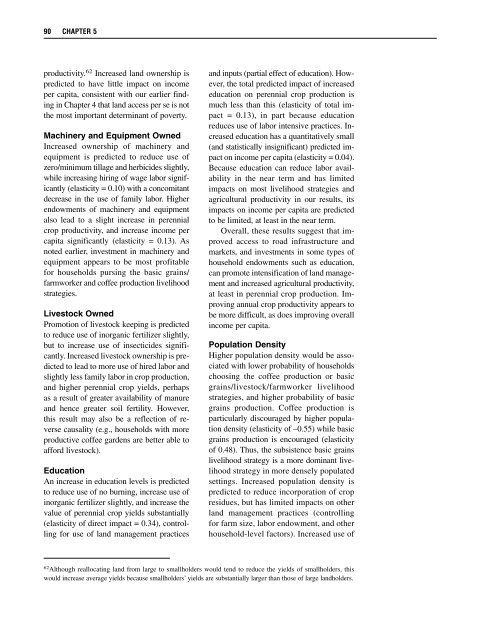Rural Development Policies and Sustainable Land Use in the ...
Rural Development Policies and Sustainable Land Use in the ...
Rural Development Policies and Sustainable Land Use in the ...
You also want an ePaper? Increase the reach of your titles
YUMPU automatically turns print PDFs into web optimized ePapers that Google loves.
90 CHAPTER 5<br />
productivity. 62 Increased l<strong>and</strong> ownership is<br />
predicted to have little impact on <strong>in</strong>come<br />
per capita, consistent with our earlier f<strong>in</strong>d<strong>in</strong>g<br />
<strong>in</strong> Chapter 4 that l<strong>and</strong> access per se is not<br />
<strong>the</strong> most important determ<strong>in</strong>ant of poverty.<br />
Mach<strong>in</strong>ery <strong>and</strong> Equipment Owned<br />
Increased ownership of mach<strong>in</strong>ery <strong>and</strong><br />
equipment is predicted to reduce use of<br />
zero/m<strong>in</strong>imum tillage <strong>and</strong> herbicides slightly,<br />
while <strong>in</strong>creas<strong>in</strong>g hir<strong>in</strong>g of wage labor significantly<br />
(elasticity = 0.10) with a concomitant<br />
decrease <strong>in</strong> <strong>the</strong> use of family labor. Higher<br />
endowments of mach<strong>in</strong>ery <strong>and</strong> equipment<br />
also lead to a slight <strong>in</strong>crease <strong>in</strong> perennial<br />
crop productivity, <strong>and</strong> <strong>in</strong>crease <strong>in</strong>come per<br />
capita significantly (elasticity = 0.13). As<br />
noted earlier, <strong>in</strong>vestment <strong>in</strong> mach<strong>in</strong>ery <strong>and</strong><br />
equipment appears to be most profitable<br />
for households purs<strong>in</strong>g <strong>the</strong> basic gra<strong>in</strong>s/<br />
farmworker <strong>and</strong> coffee production livelihood<br />
strategies.<br />
Livestock Owned<br />
Promotion of livestock keep<strong>in</strong>g is predicted<br />
to reduce use of <strong>in</strong>organic fertilizer slightly,<br />
but to <strong>in</strong>crease use of <strong>in</strong>secticides significantly.<br />
Increased livestock ownership is predicted<br />
to lead to more use of hired labor <strong>and</strong><br />
slightly less family labor <strong>in</strong> crop production,<br />
<strong>and</strong> higher perennial crop yields, perhaps<br />
as a result of greater availability of manure<br />
<strong>and</strong> hence greater soil fertility. However,<br />
this result may also be a reflection of reverse<br />
causality (e.g., households with more<br />
productive coffee gardens are better able to<br />
afford livestock).<br />
Education<br />
An <strong>in</strong>crease <strong>in</strong> education levels is predicted<br />
to reduce use of no burn<strong>in</strong>g, <strong>in</strong>crease use of<br />
<strong>in</strong>organic fertilizer slightly, <strong>and</strong> <strong>in</strong>crease <strong>the</strong><br />
value of perennial crop yields substantially<br />
(elasticity of direct impact = 0.34), controll<strong>in</strong>g<br />
for use of l<strong>and</strong> management practices<br />
<strong>and</strong> <strong>in</strong>puts (partial effect of education). However,<br />
<strong>the</strong> total predicted impact of <strong>in</strong>creased<br />
education on perennial crop production is<br />
much less than this (elasticity of total impact<br />
= 0.13), <strong>in</strong> part because education<br />
reduces use of labor <strong>in</strong>tensive practices. Increased<br />
education has a quantitatively small<br />
(<strong>and</strong> statistically <strong>in</strong>significant) predicted impact<br />
on <strong>in</strong>come per capita (elasticity = 0.04).<br />
Because education can reduce labor availability<br />
<strong>in</strong> <strong>the</strong> near term <strong>and</strong> has limited<br />
impacts on most livelihood strategies <strong>and</strong><br />
agricultural productivity <strong>in</strong> our results, its<br />
impacts on <strong>in</strong>come per capita are predicted<br />
to be limited, at least <strong>in</strong> <strong>the</strong> near term.<br />
Overall, <strong>the</strong>se results suggest that improved<br />
access to road <strong>in</strong>frastructure <strong>and</strong><br />
markets, <strong>and</strong> <strong>in</strong>vestments <strong>in</strong> some types of<br />
household endowments such as education,<br />
can promote <strong>in</strong>tensification of l<strong>and</strong> management<br />
<strong>and</strong> <strong>in</strong>creased agricultural productivity,<br />
at least <strong>in</strong> perennial crop production. Improv<strong>in</strong>g<br />
annual crop productivity appears to<br />
be more difficult, as does improv<strong>in</strong>g overall<br />
<strong>in</strong>come per capita.<br />
Population Density<br />
Higher population density would be associated<br />
with lower probability of households<br />
choos<strong>in</strong>g <strong>the</strong> coffee production or basic<br />
gra<strong>in</strong>s/livestock/farmworker livelihood<br />
strategies, <strong>and</strong> higher probability of basic<br />
gra<strong>in</strong>s production. Coffee production is<br />
particularly discouraged by higher population<br />
density (elasticity of –0.55) while basic<br />
gra<strong>in</strong>s production is encouraged (elasticity<br />
of 0.48). Thus, <strong>the</strong> subsistence basic gra<strong>in</strong>s<br />
livelihood strategy is a more dom<strong>in</strong>ant livelihood<br />
strategy <strong>in</strong> more densely populated<br />
sett<strong>in</strong>gs. Increased population density is<br />
predicted to reduce <strong>in</strong>corporation of crop<br />
residues, but has limited impacts on o<strong>the</strong>r<br />
l<strong>and</strong> management practices (controll<strong>in</strong>g<br />
for farm size, labor endowment, <strong>and</strong> o<strong>the</strong>r<br />
household-level factors). Increased use of<br />
62<br />
Although reallocat<strong>in</strong>g l<strong>and</strong> from large to smallholders would tend to reduce <strong>the</strong> yields of smallholders, this<br />
would <strong>in</strong>crease average yields because smallholders’ yields are substantially larger than those of large l<strong>and</strong>holders.
















